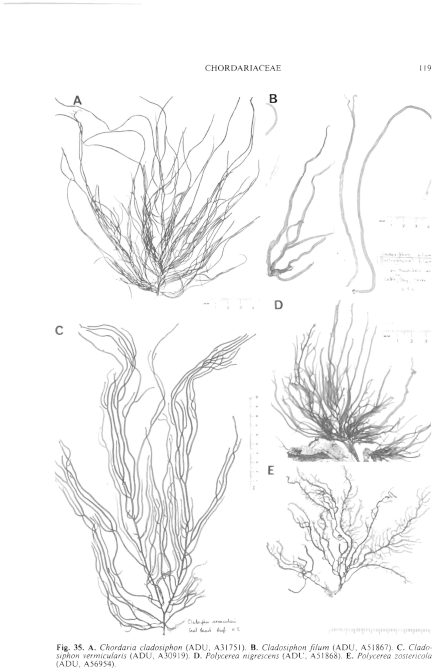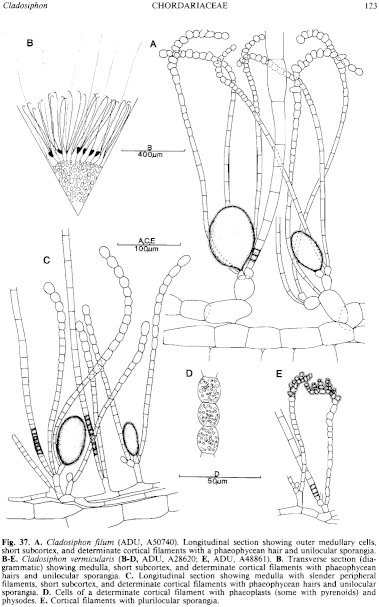|
|
|
|
|
|||||||||||
|
Electronic Flora of South Australia Species Fact Sheet
Phylum Phaeophyta – Order Chordariales – Family Chordariaceae
Selected citations: Bailey & Womersley in Womersley 1967: 233.
Synonyms
Bactrophora vermicularis J. Agardh 1882: 25.
Castagnea vermicularis (J. Agardh) Kuckuck 1929: 51, fig. 63.
Thallus (Fig. 35C) medium to dark brown, very mucoid, much branched usually with relatively long laterals, 10–50 cm long and 1.5–4 (–7) mm in diameter, with a small discoid holdfast 1–3 mm across, epilithic. Medulla (Fig. 37B,C) becoming hollow, of more or less parallel, adhering, longitudinal, cylindrical filaments 25–45 in diameter with cells L/B (1–) 1.5–6 (–20) in the inner medulla, with few to moderately abundant hyphae and with slightly slenderer peripheral filaments. Subcortex (Fig. 37C) slight, 30–50 µm broad and of 1–3 cells (branched if 2 or 3) at right angles to medullary cells, filaments 8–12 µm in diameter and cells L/B (2–) 3–6, with the inner cells producing occasional hyphae. Cortical filaments (Fig. 37B,C) arising singly or in groups from outer subcortical cells, or directly from peripheral medullary cells, simple, determinate, 200–400 (–500) Atm and 15–30 cells long when mature, curved to recurved above, with intercalary divisions; upper cells more or less moniliform, subspherical to ovoid, 10–14 µm in diameter and L/B 1–2 (–2.5), lower cells cylindrical, 6–8 µm in diameter and L/B (2–) 3–5. Phaeoplasts (Fig. 37D) several per cell, discoid, each with a pyrenoid; physodes numerous. Phaeophycean hairs (Fig. 37C) usually frequent, arising from outer subcortical cells, 8–12 µm in diameter.
Reproduction: Plurilocular sporangia (Fig. 37E) produced from upper cells of curved cortical filaments by subdivisions on their upper side, 2–4 cells and 10–30 µm long and 6–10 µm in diameter. Unilocular sporangia (Fig. 37C) borne on outer subcortical cells, ovoid to broadly clavate, usually sessile, (50–) 60–80 Arn long and 20–45 µm in diameter.
Type from Port Fairy, Vic. (Harvey, Alg. Aust. Exsicc. 91); in Herb. Agardh, LD, 46202; isotype in NSW.
Selected specimens: Head of Great Australian Bight, S. Aust., drift (Parsons, 4.xi.1968; ADU, A34187). Sou' West R., Kangaroo I., S. Aust., lower eulittoral (Bailey, 15.i.1965; ADU, A28620). Seal Beach, Kangaroo I., S. Aust., low eulittoral (Bailey, 29.x.1966; ADU, A30919). Encounter Bay, S. Aust., lower eulittoral (Skinner, 23.xi.1977; ADU, A48861, with plurilocular sporangia). Port MacDonnell, S. Aust., upper sublittoral pools ( Womersley, 25.i.1967; ADU, A31656-"Marine Algae of southern Australia" No. 44). Sorrento, Vic., reef pools ( Womersley, 13.i.1981; ADU, A51975). Cape Everard, Vic., lower eulittoral (Bailey, 25.i.1967; ADU, A30912). Three Hummocks I., Tas., upper sublittoral ( Wollaston & Mitchell, 21.ii.1964; ADU,
Distribution: From the Head of the Great Australian Bight, S. Aust. to Watsons Bay, Sydney, N.S.W. and around Tasmania, usually in the lower eulittoral or uppermost sublittoral as a summer annual (October to February).
Taxonomic notes: A27635). Watsons Bay, Sydney, N.S.W., lower eulittoral (Womersley, 27.xii.1962; ADU, A26419).
C. vermicularis is often common in the lower eulittoral on wave-washed rock in summer. While structurally similar to C. filum, they differ in habit, habitat and clearly in the diameter of the phaeophycean hairs. Nelson & Adams (1983, p.91) exclude C. vermicularis from New Zealand, previous records being misidentifications of Papenfussiella lutea.
Plants with plurilocular sporangia are not common, and are smaller and more branched, but agree with unilocular sporangial plants in other respects.
References:
AGARDH, J.G. (1882). Till algernes systematik. Acta Univ. lund. 17, 1–136, Plates 1–3.
KUCKUCK, P. (1929). Fragmente einer Monographie des Pheosporeen. Biol. Anst. Helgol. 17, 1–93.
KYLIN, H. (1940). Die Phaeophyceenordnung Chordariales. Acta Univ. lund. N.F. Avd. 2, 36(9), 1–67, Plates 1–8.
NELSON, W.A. & ADAMS, N.M. (1983). A taxonomic revision of the families Chordariaceae and Chordariopsidaceae (Phaeophyta) in New Zealand. N.Z. J. Bot. 21, 77–92.
WOMERSLEY, H.B.S. (1967). A critical survey of the marine algae of southern Australia. II. Phaeophyta. Aust. J. Bot. 15, 189–270.
The Marine Benthic Flora of Southern Australia Part II complete list of references.
Publication:
Womersley, H.B.S. (14 December, 1987)
The Marine Benthic Flora of Southern Australia
Part II
©Board of the Botanic Gardens and State Herbarium, Government of South Australia
Illustrations in Womersley Part II, 1997: FIGS 35C, 37 B–E.

Figure 35 enlarge
Fig. 35. A. Chordaria cladosiphon (ADU, A31751). B. Cladosiphon filum (ADU, A51867). C. Cladosiphon vermicularis (ADU, A30919). D. Polycerea nigrescens (ADU, A51868). E. Polycerea zostericola (ADU, A56954).

Figure 37 enlarge
Fig. 37. A. Cladosiphon filum (ADU, A50740). Longitudinal section showing outer medullary cells, short subcortex, and determinate cortical filaments with a phaeophycean hair and unilocular sporangia. B–E. Cladosiphon vermicularis (B–D, ADU, A28620; E, ADU, A48861). B. Transverse section (diagrammatic) showing medulla, short subcortex, and determinate cortical filaments with phaeophycean hairs and unilocular sporangia. C. Longitudinal section showing medulla with slender peripheral filaments, short subcortex, and determinate cortical filaments with phaeophycean hairs and unilocular sporangia. D. Cells of a determinate cortical filament with phaeoplasts (some with pyrenoids) and physodes. E. Cortical filaments with plurilocular sporangia.

|
Email Contact: State Herbarium of South Australia |

|